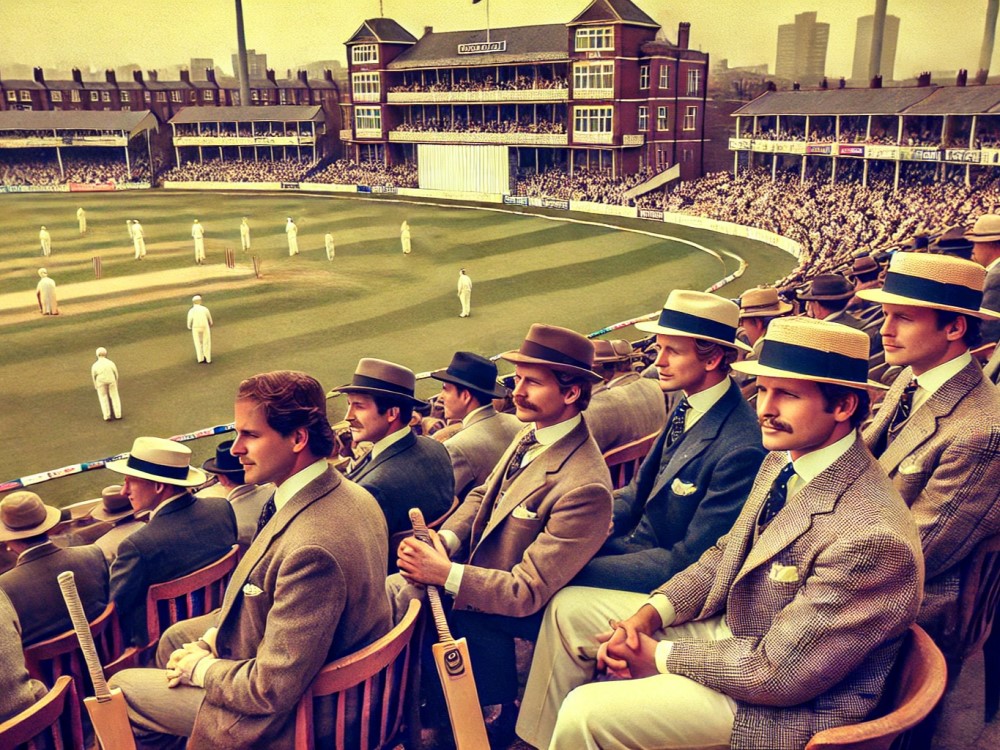
The Evolution of Cricket Spectator Experience
The evolution of cricket spectator experience has transformed significantly over the years, offering fans an increasingly immersive and engaging way to enjoy the game. From the early days of traditional seating at iconic venues like The Oval, spectators now have access to a myriad of enhancements that enrich their viewing experience.
One of the most notable aspects of this evolution is the modernization of cricket stadiums. Historic grounds such as Lord’s Cricket Ground have continually upgraded their facilities to meet the growing expectations of fans. These improvements include better seating, advanced technology for instant replays, and high-definition screens, making the live game more exciting and accessible.
The rise of cricket tourism has also played a pivotal role in enhancing the spectator experience. Fans now travel to witness matches at some of the best cricket stadiums around the world, turning game days into comprehensive travel experiences. This shift has made attending cricket matches a more holistic and enjoyable activity.
Additionally, the integration of technology into the game has brought a new dimension to how spectators engage with cricket. The advent of fitness equipment for training and nutrition products has revolutionized how players prepare, which in turn enhances the overall quality of the game that spectators witness.
Furthermore, the introduction of cricket-themed entertainment and activities within stadiums has significantly contributed to the evolution of the spectator experience. Venues now offer cricket-themed gifts and interactive zones where fans can engage in various cricket-related activities, making the experience more family-friendly and inclusive.
The digital era has also impacted how fans consume cricket content. With the rise of cricket podcasts and video games, fans can stay connected with the sport even when not at the stadium. These platforms provide in-depth analysis, behind-the-scenes content, and interactive features that keep fans engaged all year round.
The evolution of cricket spectator experience is a testament to the sport’s ability to adapt and innovate. From the historical significance of venues like The Oval and Lord’s to the modern-day enhancements and technological integrations, the experience of watching cricket has become more dynamic and engaging than ever before.
Early Days of Cricket Spectating

In the early days of cricket, spectator experiences were vastly different from what they are today. Cricket, which originated in England, saw its first organized matches in the 17th century. These matches were often played on village greens or open fields, with minimal infrastructure to accommodate spectators.
Seating arrangements were rudimentary, with spectators often bringing their own chairs or blankets to sit on. There were no dedicated stands or seating areas, and fans had to find a spot around the boundary to watch the game. The lack of facilities meant that watching cricket was a relatively modest affair, with spectators enduring the elements and limited amenities.
Despite the basic conditions, the passion for cricket was evident among fans. Matches were social events where communities gathered to support their local teams and enjoy the game. The informal and communal atmosphere contributed to the charm of early cricket spectating, creating a strong sense of camaraderie among fans.
The introduction of formal cricket grounds in the 18th century marked the beginning of improvements in spectator experience. Grounds like Lord’s Cricket Ground, established in 1814, started to provide dedicated seating areas, though these were still relatively basic by modern standards. The emphasis was on creating a space where fans could gather to watch the game, with limited focus on comfort and convenience.
The early days of cricket spectating laid the foundation for the sport’s popularity, fostering a passionate and dedicated fan base. While the spectator experience was simple and unrefined, the love for the game and the sense of community it created were crucial in establishing cricket as a beloved sport.
Development of Cricket Stadiums
The development of cricket stadiums significantly enhanced the spectator experience, transforming how fans watched and enjoyed the game. The late 19th and early 20th centuries saw the construction of purpose-built cricket stadiums with improved facilities and amenities.
One of the most notable advancements was the introduction of grandstands and seating arrangements. Stadiums like The Oval and Old Trafford in England began to feature permanent stands with tiered seating, providing better views of the pitch and greater comfort for spectators. These developments made watching cricket more accessible and enjoyable, attracting larger crowds to matches.
The establishment of iconic stadiums around the world further enhanced the spectator experience. In Australia, the Melbourne Cricket Ground (MCG) became a premier venue for cricket, offering extensive seating, excellent sightlines, and modern amenities. Similarly, Eden Gardens in Kolkata, India, emerged as a cricketing mecca with its vast seating capacity and passionate fan base.
Stadiums also began to incorporate facilities such as pavilions, hospitality suites, and dedicated areas for media and VIPs. These additions catered to a diverse range of spectators, from general fans to corporate guests, enhancing the overall match-day experience.
The introduction of floodlights in the mid-20th century revolutionized cricket spectating. Day-night matches allowed fans to watch cricket after work hours, significantly increasing attendance and broadening the sport’s appeal. The ability to play under lights also led to the creation of limited-overs formats like One Day Internationals (ODIs) and later Twenty20 (T20) cricket, which further attracted fans with their fast-paced and exciting nature.
Modern cricket stadiums continue to evolve, with a focus on enhancing fan comfort and engagement. Innovations such as retractable roofs, advanced seating designs, and improved accessibility have made stadiums more accommodating. Additionally, stadiums now offer a wide range of amenities, including diverse food and beverage options, merchandise stores, and entertainment zones, ensuring a comprehensive and enjoyable experience for spectators.
The development of cricket stadiums has been instrumental in transforming the spectator experience, providing fans with comfortable and modern environments to enjoy the game. These advancements have played a crucial role in growing the sport’s popularity and making cricket matches memorable events for fans worldwide.
Technological Advancements in Broadcasting

The advent of technology has had a profound impact on the cricket spectator experience, particularly through advancements in broadcasting. From the early days of radio commentary to the high-definition broadcasts and interactive features of today, technology has transformed how fans watch and engage with cricket.
Radio commentary was one of the first technological innovations to enhance the spectator experience. Introduced in the 1920s, radio allowed fans to follow cricket matches in real-time, even if they couldn’t be at the ground. Commentators brought the game to life with their descriptions, creating a sense of excitement and connection for listeners.
Television broadcasting, which began in the 1950s, revolutionized cricket spectating. Fans could now watch live matches from the comfort of their homes, with visuals providing a more immersive experience. The introduction of color television in the 1970s further enhanced the viewing experience, making the game more vibrant and engaging.
High-definition (HD) and ultra-high-definition (UHD) broadcasts have taken cricket viewing to new heights. These technologies provide crystal-clear images and enhanced details, allowing fans to see every nuance of the game. Slow-motion replays, multiple camera angles, and graphics overlays have added depth to the coverage, helping viewers understand and appreciate the intricacies of cricket.
The introduction of digital platforms and streaming services has further transformed the spectator experience. Fans can now watch matches on their smartphones, tablets, and computers, providing greater flexibility and convenience. Streaming services often offer additional features such as live stats, interactive scorecards, and multiple language commentary, enhancing the overall viewing experience.
Technological advancements have also led to the development of innovative tools such as Hawk-Eye, Snickometer, and Hot Spot. These technologies provide detailed analysis of ball trajectories, edges, and impacts, helping viewers understand contentious decisions and adding a new layer of excitement to the game.
Virtual and augmented reality (VR and AR) are emerging technologies that promise to revolutionize cricket spectating. VR can provide immersive experiences, allowing fans to feel as if they are at the stadium, while AR can overlay information and graphics onto the real world, enhancing the viewing experience.
Technological advancements in broadcasting have made cricket more accessible, engaging, and enjoyable for fans around the world. These innovations have transformed how cricket is consumed, providing a richer and more interactive experience that continues to evolve with each passing year.
Enhanced Fan Engagement
The evolution of cricket spectator experience has seen a significant focus on enhancing fan engagement. Modern cricket matches are not just about watching the game; they are immersive experiences that involve fans in various interactive and engaging ways.
Social media has played a crucial role in transforming fan engagement. Platforms like Twitter, Facebook, and Instagram allow fans to connect with their favorite players, teams, and fellow fans. Live updates, behind-the-scenes content, and interactive polls and quizzes keep fans engaged and connected throughout the match. Social media also provides a platform for fans to share their thoughts, reactions, and experiences, creating a global community of cricket enthusiasts.
Stadiums have also embraced technology to enhance fan engagement. Many venues now offer free Wi-Fi, allowing fans to stay connected and share their experiences in real-time. Mobile apps provide additional features such as live stats, player profiles, and interactive maps of the stadium, helping fans navigate and enjoy their match-day experience.
In-stadium entertainment has become an integral part of the spectator experience. Music, dance performances, and interactive games during breaks keep the energy levels high and ensure that fans are entertained throughout the match. Big screens display replays, fan reactions, and social media updates, creating a dynamic and engaging atmosphere.
Fan zones and hospitality areas provide dedicated spaces for fans to relax and enjoy the match. These areas often feature comfortable seating, food and beverage options, and interactive activities. Fan zones also host player meet-and-greets, autograph sessions, and photo opportunities, allowing fans to interact with their favorite cricketers.
Themed events and promotions add an extra layer of excitement to the spectator experience. Special match-day themes, such as retro day, superhero day, or charity events, create a festive atmosphere and encourage fan participation. Promotions, giveaways, and contests offer fans the chance to win prizes and engage more deeply with the match.
Interactive technologies such as augmented reality (AR) and virtual reality (VR) are also enhancing fan engagement. AR apps can provide interactive experiences, such as virtual tours of the stadium or AR games that fans can play during breaks. VR offers immersive experiences, allowing fans to feel as if they are on the field or in the stands, even from the comfort of their homes.
Enhanced fan engagement has transformed cricket matches into immersive and interactive experiences. These innovations have made spectating more enjoyable and created deeper connections between fans, players, and the sport.
Evolution of In-Stadium Amenities

The evolution of in-stadium amenities has significantly improved the cricket spectator experience. Modern cricket stadiums offer a wide range of amenities that enhance comfort, convenience, and overall enjoyment for fans.
One of the most notable improvements is in seating arrangements. Modern stadiums feature comfortable, ergonomic seats with excellent sightlines, ensuring that fans have a clear view of the action. Premium seating options, such as executive boxes and VIP lounges, offer additional comfort and exclusivity, providing an enhanced experience for corporate guests and high-profile spectators.
Accessibility has also been a major focus in the evolution of stadium amenities. Modern stadiums are designed to be inclusive and accessible to all fans, including those with disabilities. Features such as ramps, elevators, designated seating areas, and accessible restrooms ensure that everyone can enjoy the match without any barriers.
Food and beverage options have seen significant advancements in cricket stadiums. Gone are the days of limited and basic refreshments. Modern stadiums offer a wide variety of food and drink options, catering to diverse tastes and dietary requirements. From traditional snacks and fast food to gourmet meals and international cuisine, fans can enjoy a culinary experience that complements the excitement of the match.
Merchandise stores and kiosks within stadiums provide fans with the opportunity to purchase team apparel, memorabilia, and souvenirs. These stores offer a wide range of products, from jerseys and caps to autographed items and limited-edition collectibles. The availability of merchandise enhances the fan experience and allows supporters to show their loyalty and support for their favorite teams.
Clean and well-maintained restrooms are another important aspect of in-stadium amenities. Modern stadiums prioritize hygiene and cleanliness, ensuring that restrooms are regularly cleaned and stocked with necessary supplies. Adequate restroom facilities help improve the overall comfort and satisfaction of spectators.
Family-friendly amenities have also become a key feature of modern cricket stadiums. Dedicated family zones, kids’ play areas, and family-friendly seating sections provide a safe and enjoyable environment for families attending matches. These areas often include activities and entertainment specifically designed for children, making cricket matches a fun outing for the whole family.
Enhanced security measures have been implemented to ensure the safety and well-being of spectators. Modern stadiums are equipped with advanced surveillance systems, security personnel, and crowd management strategies to prevent incidents and ensure a safe environment for all attendees.
The evolution of in-stadium amenities has transformed cricket matches into comprehensive and enjoyable experiences. By focusing on comfort, convenience, and inclusivity, modern stadiums have made significant strides in enhancing the spectator experience and ensuring that fans have a memorable and satisfying time at the game.
Impact of Digital Innovations
Digital innovations have had a profound impact on the cricket spectator experience, transforming how fans watch, engage with, and enjoy the game. These advancements have made cricket more accessible, interactive, and immersive, providing fans with new and exciting ways to connect with the sport.
One of the most significant digital innovations is the rise of streaming services. Platforms like Hotstar, ESPN+, and Willow TV have revolutionized how fans watch cricket. These services offer live streaming of matches, allowing fans to watch games on their smartphones, tablets, and computers from anywhere in the world. Streaming services often include additional features such as multi-camera views, real-time stats, and interactive scorecards, enhancing the viewing experience.
Social media platforms have become integral to the cricket spectator experience. Fans can follow live updates, engage in discussions, and share their reactions on platforms like Twitter, Facebook, and Instagram. Social media also provides a direct connection between fans and players, with cricketers sharing insights, behind-the-scenes content, and interacting with their supporters. Hashtags, polls, and live chats create a dynamic and interactive environment, making fans feel more involved in the game.
Mobile apps have transformed how fans engage with cricket. Official apps from cricket boards, leagues, and teams provide a wealth of information, including live scores, match schedules, player profiles, and news updates. These apps often include interactive features such as fantasy cricket, where fans can create and manage their own teams, and augmented reality (AR) experiences, where fans can view 3D models of players and stadiums.
Virtual reality (VR) and augmented reality (AR) technologies are pushing the boundaries of the cricket spectator experience. VR can provide immersive experiences, allowing fans to feel as if they are in the stadium, watching the game from the best seats. AR can overlay information and graphics onto the real world, enhancing the viewing experience with interactive elements. For example, AR apps can display player stats, ball trajectories, and live scoreboards, providing fans with a deeper understanding of the game.
E-sports and gaming have also made their mark on the cricket spectator experience. Cricket video games and simulations allow fans to play as their favorite teams and players, experiencing the thrill of the game in a virtual setting. These games often include realistic graphics, player likenesses, and authentic gameplay, providing an engaging and entertaining experience for fans.
Digital innovations have also improved in-stadium experiences. Wi-Fi connectivity, mobile ticketing, and cashless payment systems enhance convenience for fans attending matches. Interactive screens, real-time stats, and live social media feeds keep fans engaged and informed throughout the game.
The impact of digital innovations on the cricket spectator experience has been transformative. By making cricket more accessible, interactive, and immersive, these advancements have created new opportunities for fans to connect with the sport and enjoy the game in exciting and innovative ways.
The Evolution of Cricket Spectator Experience: Transforming the Way Fans Enjoy the Game

The evolution of cricket spectator experience has been marked by significant advancements in stadium infrastructure, broadcasting technology, fan engagement, and digital innovations. From the early days of rudimentary seating and minimal amenities to the modern era of state-of-the-art stadiums, high-definition broadcasts, and interactive digital platforms, the way fans experience cricket has transformed dramatically.
Improvements in stadium facilities have enhanced comfort, convenience, and accessibility for spectators, making attending matches a more enjoyable and memorable experience. Modern stadiums now boast comfortable seating, advanced lighting, high-quality sound systems, and a variety of food and beverage options. These upgrades ensure that fans can enjoy the game in a pleasant environment, with all the amenities needed for a great day out.
Technological advancements in broadcasting have brought the game to fans worldwide, providing immersive and engaging viewing experiences. High-definition and ultra-high-definition broadcasts, along with advanced camera technologies like spider cams and drone views, offer fans unparalleled perspectives of the game. Commentary and analysis have also evolved, with expert insights and real-time statistics enhancing the understanding and enjoyment of the sport.
Enhanced fan engagement initiatives have created interactive and dynamic environments, fostering a deeper connection between fans, players, and the sport. Initiatives such as fan zones, live entertainment, and interactive displays at stadiums make match days more than just about the game—they become holistic experiences that engage all senses and interests. Social media interactions and live fan polls further bridge the gap between the spectators and the players, making fans feel an integral part of the game.
Digital innovations have further revolutionized the cricket spectator experience, making cricket more accessible and interactive through streaming services, social media, mobile apps, and virtual reality. Streaming services allow fans to watch matches live or on-demand from anywhere in the world, while mobile apps provide real-time updates, player stats, and interactive features. Virtual reality has begun to offer immersive experiences, allowing fans to feel as though they are right in the stadium, even from the comfort of their own homes.
These advancements have transformed how fans watch, engage with, and enjoy cricket, creating new opportunities for connection and involvement. The ability to interact with other fans, participate in fantasy leagues, and access a wealth of information at their fingertips has made the cricket spectator experience richer and more engaging than ever before.
As cricket continues to evolve, the spectator experience will undoubtedly continue to improve, driven by ongoing innovations and a commitment to enhancing fan satisfaction. The evolution of cricket spectator experience reflects the sport’s ability to adapt and thrive in a changing world, ensuring that cricket remains a beloved and exciting sport for fans around the globe. By embracing these advancements, cricket will continue to captivate and connect with its diverse and global fan base, securing its place as a premier international sport.





